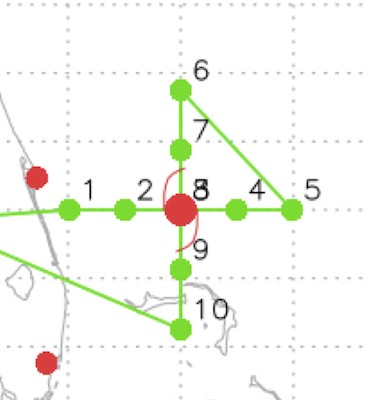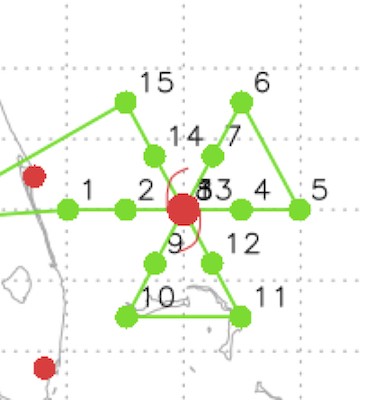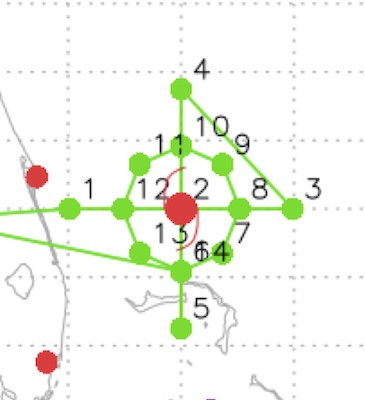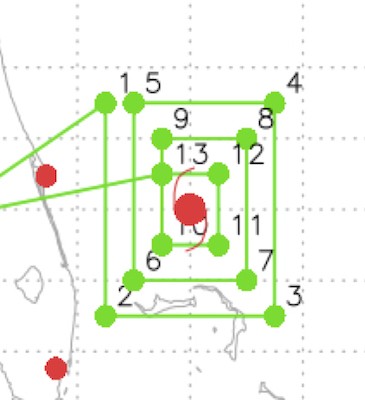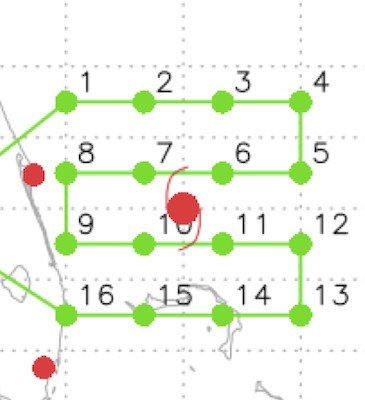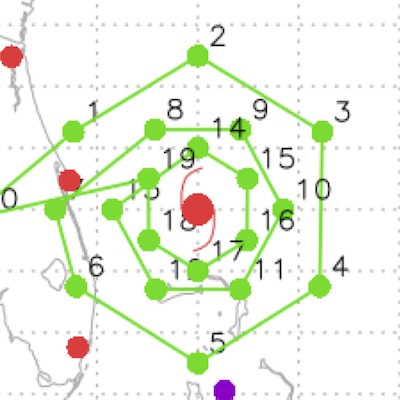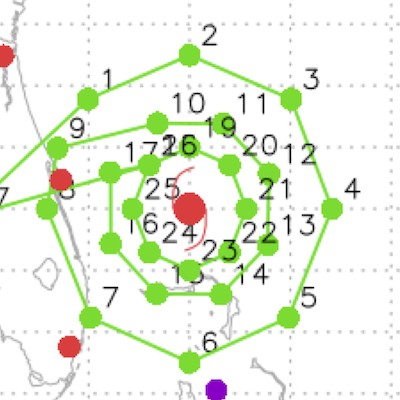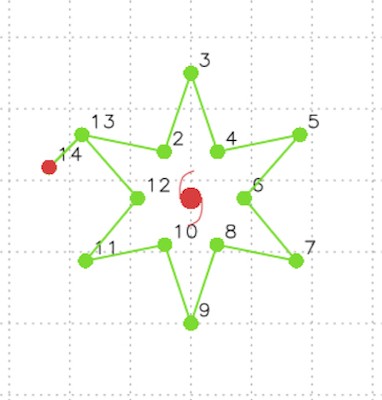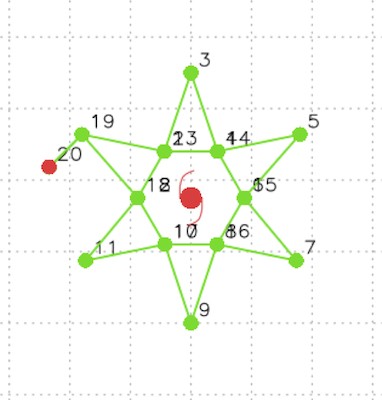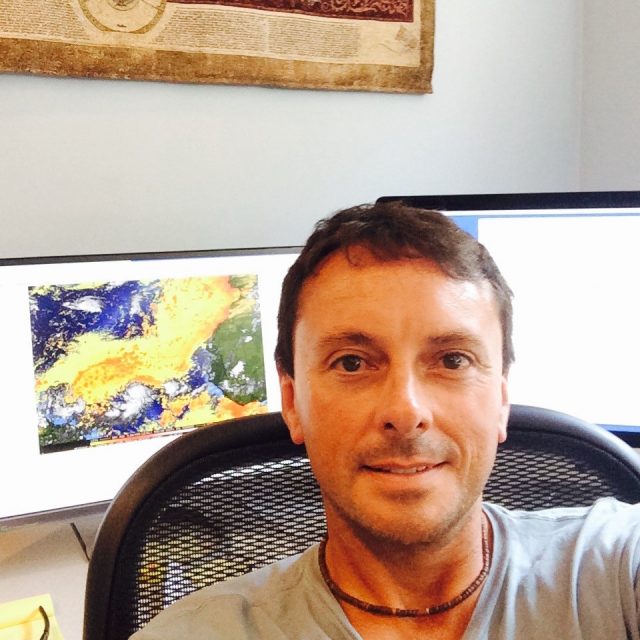Hurricane Field Program
2022 Hurricane Season
Scroll to Learn More
On this page you can find detailed descriptions of the research field activities planned for the current hurricane season. The 2022 Hurricane Field Program supports NOAA’s Advancing the Prediction of Hurricanes Experiment (APHEX). This page is organized by projects that support research of the lifecycle stages of storms, from genesis to end stage, as well as ocean observations and satellite validation.
About APHEX: Developed in partnership with NOAA’s Environmental Modeling Center, National Hurricane Center, Aircraft Operations Center, and AOML’s Physical Oceanography Division, APHEX is intended to improve our understanding and prediction of hurricane track, intensity, structure, and associated hazards by collecting observations that will aid in the improvement of current operational hurricane models, such as the Hurricane Weather Research and Forecasting model, and the development of the next-generation operational hurricane models.
We are building a Weather-Ready Nation.
Supporting NOAA Operations.
With research to operational links within the HFP-APHEX Plan and through satellite validation to enhance operational utilization of satellite data.
See How the Hurricane Field Program Supports NOAA Operations.
This document outlines the support HRD provides for operationally-tasked (EMC/NHC) NOAA hurricane aircraft missions. In the event of an operationally-tasked mission, HRD will provide support to ensure the mission achieves its goals. Click on the link below to read full documentation.
Genesis Stage
Favorable Air Mass (FAM)
Investigators
Jon Zawislak, Ghassan Alaka, Jason Dunion, Sharan Majumdar (Univ. of Miami/RSMAS), Alexis Wilson (Univ. of Miami/RSMAS), Quinton Lawton (Univ. of Miami/RSMAS), Alan Brammer (CSU/CIRA/NOAA), Chris Thorncroft (SUNY Albany)
Science Description
Although the ingredients for tropical cyclone formation have been well-documented for decades, it is still difficult to predict which disturbances will develop and which ones will not. A big factor in this uncertainty is the favorability of the air mass ahead of, and interacting with, the disturbance. This experiment proposes to collect observations of mid- level humidity and winds to assess the favorability of the disturbance’s environment for tropical cyclogenesis. These aircraft observations may also provide helpful guidance for the expanded use of satellite observations in the absence of aircraft observations.
Full Documentation
Download PDFs:
Precipitation during Formation and Observing its Response across Multiple Scales (PREFORM)
Investigators
Jon Zawislak, Ghassan Alaka, Rob Rogers, Jason Dunion, Paul Reasor, Sharan Majumdar (Univ. of Miami/RSMAS), Alexis Wilson (Univ. of Miami/RSMAS), and Quinton Lawton (Univ. of Miami/RSMAS)
Science Description
An accurate prediction of hurricane formation requires an improved knowledge of the precipitation (rainfall) organization and the developing storm circulation response, in the context of environmental characteristics, during the formation process. The overall goal of this experiment is to use aircraft observations to investigate how precipitation (rainfall) within a tropical disturbance (such as an African easterly wave) is involved in the development and intensification of an incipient tropical storm circulation by sampling the characteristics of the precipitation, as well as the thermodynamic and wind structure of the circulation.
Full Documentation
Download PDFs:
Early Stage
Analysis of Intensity Change Processes Experiment (AIPEX)
Investigators
Jon Zawislak, Rob Rogers, Jason Dunion, Josh Alland (NCAR), Rosimar Rios-Berrios (NCAR), George Bryan (NCAR), Falko Judt (NCAR), Michael Fischer, Jun Zhang, Paul Reasor, Joe Cione, Trey Alvey, Xiaomin Chen, Ghassan Alaka, Heather Holbach, and Josh Wadler
Science Description
Predicting the timing and rate of tropical cyclone (TC) strengthening events remains one of the most challenging aspects of hurricane forecasting. In their early stages, the structure of developing storms is often disorganized such that their circulations are tilted in the vertical, have prominent dry air masses that can be transported into the inner circulation, and lack rainfall coverage all around the center. These are all conditions that would otherwise be considered unfavorable for further strengthening and are often a consequence of the storm experiencing unfavorable winds in its environment. Storms with these characteristics can, however, strengthen and the goal of this experiment is to understand the physical processes and structures that govern whether storms will intensify in this type of environment.
Full Documentation
Download PDFs:
Convective Burst Structure and Evolution Module (CBM)
Investigators
Rob Rogers (PI), Jon Zawislak, Trey Alvey, Josh Wadler, Robert Black, Hua Leighton, Xuejin Zhang, Michael Bell (CSU), Anthony Didlake (PSU), Jim Doyle (NRL), Dan Stern (NRL)
Science Description
This module samples the vertical motion and reflectivity structure of strong thunderstorm complexes at a high frequency, e.g., every 15–20 minutes, over a 1–2 h period, to observe how the structure of these systems change over time and as they move around the TC center, along with observing how those changes affect the structure and intensity of TCs.
Full Documentation
Download PDFs:
Impact of Targeted Observations on Forecasts (ITOFS)
Investigators
Jason Dunion (Co-PI), Jon Zawislak, Sim Aberson (Co-PI), Kelly Ryan, Jason Sippel, Ryan Torn (Univ at Albany-SUNY), Jim Doyle (NRL-Monterey), Eric Blake (NWS/NHC), Mike Brennan (NWS/NHC), Chris Landsea (NWS/TAFB)
Science Description
This experiment will use advanced guidance from multiple sets of forecast models to determine locations where aircraft observations could potentially improve forecasts of tropical cyclone track, intensity and structure.
Full Documentation
Download PDFs:
Stratiform Spiral Module (SSM)
Investigators
Rob Rogers (PI), Jon Zawislak, Trey Alvey, Robert Black, Josh Wadler, Hua Leighton, Xuejin Zhang, Michael Bell (CSU), Anthony Didlake (PSU), Jim Doyle (NRL), Dan Stern (NRL)
Science Description
This module samples the distribution of cloud and rain droplets and ice and snow particles and how those distributions vary with altitude across the freezing level in broad regions of relatively weak precipitation and upward motion.
Full Documentation
Download PDFs:
Mature Stage
Eye-Eyewall Mixing
Investigators
Sim Aberson, Joe Cione, Joshua Wadler, Jun Zhang
Science Description
Small features in the eyewalls of very intense tropical cyclones have been hypothesized to increase the amount of energy available for hurricane intensification, or to be responsible for damaging surface wind at landfall or intense turbulence features impacting flight operations. However, the structures of these features, especially the temperature and humidity structures, have never been documented.
Full Documentation
Download PDFs:
Gravity Wave
Investigators
Jun Zhang and David Nolan (U. Miami)
Science Description
Tropical cyclone (TC) convection produces gravity waves that propagate both upward and outward. The observational data collected from this module will be analyzed to quantify the characteristics of the gravity waves in mature-stage hurricanes and their relationship with storm intensity and intensity change. These data would also provide valuable information for model evaluation and physics improvement.
Full Documentation
Download PDFs:
Hurricane Boundary Layer
Investigators
Jun Zhang, Daniel Stern (NRL), Sue Chen (NRL), Joseph Cione, Elizabeth Sanabia (USNA), Robert Rogers, Joshua Wadler, Xiaomin Chen, Jason Dunion, Jonathan Zawislak, Andrew Hazelton, Frank Marks, Nick Shay (RSMAS), Johna Rudzin (MSU), James Doyle (NRL), Yi Jin (NRL), George Bryan (NCAR), Rosimar Rios-Berrios (NCAR), Falko Judt (NCAR), Brian Tang (SUNY Albany), Robert Fovell (SUNY Albany), Michael Bell (CSU), Zhien Wang (CU), Ralph Foster (UW), Cheyenne Stienbarger (GOMO), and Emily A. Smith (GOMO)
Science Description
The atmospheric boundary layer is a crucial region of a tropical cyclone (TC), because it is the area of the storm in direct contact with the ocean moisture and heat sources which power the storm. This module aims to collect observational data to improve our understanding of physical processes in the boundary layer that control the TC intensity change. These data can be used to evaluate and improve the performance of TC forecast models.
Full Documentation
Download PDFs:
NESDIS Ocean Winds
Investigators
Paul Chang (PI, NOAA/NESDIS/STAR), Zorana Jelenak (NOAA/NESDIS/STAR), Joe Sapp (NOAA/NESDIS/STAR)
Science Description
To improve our understanding of microwave retrievals of the ocean surface and atmospheric wind fields, and to evaluate new remote sensing techniques/technologies. To help validate satellite-based sensors of the ocean surface in extreme conditions and reduce risk for future satellite missions. To provide forecasters with near-real-time hurricane boundary layer profiles, where possible.
Full Documentation
Download PDFs:
Rainband Complex Module (RCM)
Investigators
Rob Rogers (PI), Michael Fischer, Anthony Didlake (PSU), Michael Bell (CSU), Anthony Wimmers (UWisc), Jim Doyle (NRL), Dan Stern (NRL)
Science Description
This module will sample the structure of long, spiral bands of rainfall (rainbands) that often extend outward from the eyewall of strong hurricanes out to very large distances from the center. These rainbands, often containing mixtures of strong thunderstorms and lighter rainfall that can cover huge areas, are thought to affect the structure and intensity of the hurricane within which they are embedded. The data from this module will seek to explore these structures and their potential relationship with hurricane structure and evolution.
Full Documentation
Download PDFs:
Research In Coordination with Operations Small Uncrewed Air Vehicle Experiment (RICO SUAVE)
Investigators
Joseph Cione, Jun Zhang, Josh Wadler, George Bryan (NCAR), Ron Dobosy (NOAA/ARL-ret), Altug Aksoy, Sim Aberson, Frank Marks, Kelly Ryan, Brittany Dahl, Xiaomin Chen, Johna Rudzin-Schwing, (MS State), Josh Alland (NCAR), Rosimar Rios-Berrios (NCAR), Evan Kalina (NOAA/DTC), Don Lenschow (NCAR), Chris Rozoff (NCAR), Eric Hendricks (NCAR), Falko Judt (NCAR), Jonathan Vigh (NCAR)
Science Description
This experiment uses small drones, instead of crewed aircraft, to sample the lowest and most dangerous regions of the tropical cyclone (TC). It is believed that observations from these unique platforms will improve basic understanding and enhance forecaster situational awareness. Detailed analyses of data collected from these small drones also have the potential to improve the physics of computer models that predict changes in storm intensity.
Full Documentation
Download PDFs:
Surface Wind and Wave Validation
Investigators
Heather Holbach, Ivan PopStefanija (ProSensing Inc.), Mark Bourassa (FSU), Tony Wimmers (UW-SSEC), Jim Doyle (NRL), Sue Chen (NRL), James Cummings (NRL), Ralph Foster (UW-APL), and Steve Guimond (UMBC)
Science Description
This module will collect data in mature hurricanes to continue improving surface wind speed and rain rate estimates from the Stepped-Frequency Microwave Radiometer (SFMR) and understand how the wind speed observations from the SFMR, flight-level winds, dropsondes, tail-Doppler radar (TDR) and, Imaging Wind and Rain Airborne Profiler (IWRAP) relate to each other and to a 1-minute mean (or sustained) wind. It will also aid the development of surface wind products from synthetic aperture radar (SAR) satellites. Additionally, surface wave observations will be verified and the extent of 8 ft significant wave height waves will be identified. Improved measurements from the SFMR and understanding how
the various aircraft-based wind observations relate to each other and to a 1-minute mean wind along with improving surface wind products from SAR and our knowledge of the surface wave field have numerous implications for forecasting and research efforts, such as providing more
accurate observations to estimate tropical cyclone (TC) intensity and size along with improved estimates of marine hazards and comparisons for satellite observations. These improvements allow for better watches and warnings for a TC’s potential impacts to be provided to emergency managers and the general public and leads to more accurate research results.
Full Documentation
Download PDFs:
Tail Doppler Radar Analysis Evaluation Module
Investigators
Paul Reasor, John Gamache and Peter Dodge
Science Description
Three-dimensional wind analyses derived from two P-3 aircraft equipped with tail-Doppler radar (TDR) and flying simultaneous, perpendicular transects through the hurricane eyewall are compared in an evaluation of the Doppler-radar wind analysis method. Through this evaluation, we seek to gain a better understanding of how to relate radar-derived peak wind speed and other aspects of hurricane wind structure to similar estimates using conventional observations.
Full Documentation
Download PDFs:
Tropical Cyclone Diurnal Cycle
Investigators
Jason Dunion (PI), Jun Zhang (Co-PI), Morgan O’Neill (Stanford Univ.), Daniel Chavas (Purdue Univ.), and Allison Wing (Florida State University), Dave Raymond (New Mexico Tech), Zeljka Fuchs-Stone (New Mexico Tech)
Science Description
This module aims to collect observations that improve the understanding of how day-night fluctuations in radiation affect the intensity and structure of hurricanes. One component of these oscillations is a phenomenon called the tropical cyclone diurnal cycle where the cloud fields of storms are seen to expand and contract each day. These daily expansions are associated with a pulse of thunderstorms and rain that travel hundreds of kilometers away from the storm center that affects the flow of air into the storm at the lowest levels above the ocean.
Full Documentation
Download PDFs:
Ventilation Module
Investigators
Brian Tang (UAlbany), Rosimar Rios-Berrios (NCAR), Jun Zhang (U. of Miami/CIMAS & HRD), George Bryan (NCAR), Falko Judt (NCAR), Robert Fovell (UAlbany)
Science Description
Ventilation occurs when drier and/or cooler environmental air intrudes into a vertically sheared tropical cyclone (TC). Ventilation pathways include lateral intrusion (radial ventilation) and downward intrusion (downdraft ventilation) of dry and/or cool air. Both pathways may weaken a TC or delay its intensification. This module aims to collect observational data to study ventilation pathways, validate model simulations of ventilation in sheared TCs, and assess the link between ventilation and intensity changes.
Full Documentation
Download PDFs:
End Stage
Tropical Cyclones at Landfall
Investigators
Heather Holbach, Jun Zhang, John Kaplan, Peter Dodge, Ghassan Alaka, Frank Marks, Lew Gramer, Trey Alvey, Xiaomin Chen, Forrest Masters (University of Florida), Michael Biggerstaff (University of Oklahoma), David Nolan (University of Miami), Johna Rudzin (Mississippi State University), and John Schroeder (Texas Tech University)
Science Description
Landfalling tropical cyclones (TCs) often produce a variety of high impact weather over land including tornadoes and damaging winds (particularly gusts) for which there exists limited objective forecast guidance. Thus, our experiment seeks to utilize P-3 aircraft and land- based mobile research team instruments to collect data in landfalling TCs to improve both our understanding and capability to predict the dangerous phenomena often associated with these landfalling systems.
Full Documentation
Download PDFs:
Extratropical Transition
Investigators
Sim Aberson
Science Description
Tropical cyclones can either decay (spin down) or transform into powerful extratropical cyclones when they encounter cold water below or high wind shear in the atmosphere. The mechanisms by which tropical cyclones become extratropical is not well forecast by numerical models leading to large errors, especially in impacts downstream of the actual transitioning cyclone. This experiment aims to improve forecasts of these systems.
Full Documentation
Download PDFs:
Ocean Observing
Ocean Survey
Investigators
Jun Zhang, Nick Shay (RSMAS), Joseph Cione, Sue Chen (NRL), Benjamin Jaimes (RSMAS), Joshua Wadler, Elizabeth Sanabia (USNA), Johna Rudzin (MSU), Lew Gramer, Heather Holbach, Rick Lumpkin (PHOD), Gregory Foltz (PHOD), Gustavo Goni (PHOD), James Doyle (NRL), James Cummings (NRL), Luca Centurioni (SIO), Theresa Paluszkiewicz (OOC, LLC), Steven Jayne (WHOI), Chidong Zhang (PMEL), Dongxiao Zhang (PMEL), Christian Meinig (PMEL), Cheyenne Stienbarger (GOMO), and Emily A. Smith (GOMO)
Science Description
Physical representation of how the atmosphere and ocean interact in numerical forecast models of tropical cyclones (TCs) have not been fully evaluated against observations. Near collocated and simultaneous measurements of the ocean and the atmosphere just above the ocean surface, the energy exchanges that occur between them, and how they change over time have been lacking and require close coordination across a wide array of ocean and atmosphere observing platforms. This experiment will provide a unique opportunity to evaluate how well forecast models represent these lowest regions of storms. The observations that are collected should help improve how forecast models represent interactions between the ocean and atmosphere in hurricanes.
Full Documentation
Download PDFs:
Sustained and Targeted Ocean Observations
Investigators
Cheyenne Stienbarger (NOAA/GOMO), Gustavo Goni (NOAA/AOML), Travis Miles (Rutgers University), Emily A. Smith (NOAA/GOMO), Joseph Cione (NOAA/AOML), Paul Chang (NOAA/NESDIS), Joshua Wadler (NOAA/AOML and UM/CIMAS), Jun Zhang (NOAA/AOML and UM/CIMAS), Chidong Zhang (NOAA/PMEL), Dongxiao Zhang (CICOES/UW and NOAA/PMEL), Greg Foltz (NOAA/AOML), Johna Rudzin (Mississippi State University/Northern Gulf Institute), Steven Jayne (Woods Hole Oceanographic Institution), Luca Centurioni (Scripps Institution of Oceanography), Martha Schönau (Scripps Institution of Oceanography), Kathleen Bailey (NOAA/IOOS), Hyun-Sook Kim (NOAA/AOML), Chris Fairall (NOAA/PSL), Rick Lumpkin (NOAA/AOML), Julio Morell (IOOS/CARICOOS), Patricia Chardon-Maldonado (IOOS/CARICOOS), Doug Wilson (OCOVI), Scott Glenn (Rutgers University), Kerri Whilden (Texas A&M University), Catherine Edwards (IOOS/SECOORA), Kevin Martin (University Southern Mississippi), Francis Bringas (NOAA/AOML), Joaquin Trinanes (CIMAS, NOAA/AOML), Marjahn Finlayson (CEI, Bahamas), NIck Higgs (CEI, Bahamas), Jimmy Garcia Savinon (ANAMAR, Dominican Republic), Leo Werner (ANAMAR Dominican Republic)
Science Description
The goal of this module is to provide ocean observations that will serve for analysis to improve the ocean representation in hurricane forecast coupled models, improve our understanding of the air-sea transition zone (the upper ocean, air-sea interface, and marine atmospheric boundary layer), and to increase situational awareness about the types of ocean observations available. Sustained and targeted ocean observations will be directed to monitor essential ocean features (e.g., ocean currents, eddies, warm pools, freshwater barrier layers, and subsurface cool pools) known to be linked to TC changes for use in analysis and to improve the ocean representation in coupled models to forecast TC intensity. Sustained (year-round) and seasonal observations will be mainly conducted from underwater gliders, saildrones, Argo floats, drifters, and XBTs, while targeted observations may also come from these observing platforms plus from air-deployed assets (ALAMO floats, drifters, AXBTs) and airborne remote sensing instruments, some of which are described in other modules, and from specifically designed operations to help better assess the ocean impact on TCs (e.g., co-located saildrones-glider pairs).
Full Documentation
Download PDFs:
Satellite Validation
NESDIS JPSS
Investigators
Rebekah Esmaili (STC/JPSS), Jason Dunion (HRD), Michael Folmer (NWS/OPC), Jon Zawislak (HRD)
Science Description
This module will collocate GPS dropsondes with real-time satellite sounding products to understand the near and surrounding environment of pre-Tropical Cyclones and/or Tropical Cyclones. The focus of this year’s flights is extratropical transition, tropical transitions, and invests, if useful cases arise. This module will also explore the value of satellite soundings for Tropical Cyclone monitoring and forecasting using newly developed web-based and software tools.
Full Documentation
Download PDFs:
NASA TROPICS Pathfinder
Investigators
Brittany Dahl (co-PI), Jason Dunion (co-PI), Rob Rogers (co-PI), Jon Zawislak (co-PI), Trey Alvey, William Blackwell (MIT, Lincoln Laboratory)
Science Description
This experiment is designed to calibrate and validate temperature, moisture, and precipitation measurements obtained from the new TROPICS satellites. These profiles will be compared to NOAA P-3 and G-IV aircraft observations, whose flight patterns will be coordinated in space and time with overpasses from the satellite.
Full Documentation
Download PDFs:
Operational Flight Maps
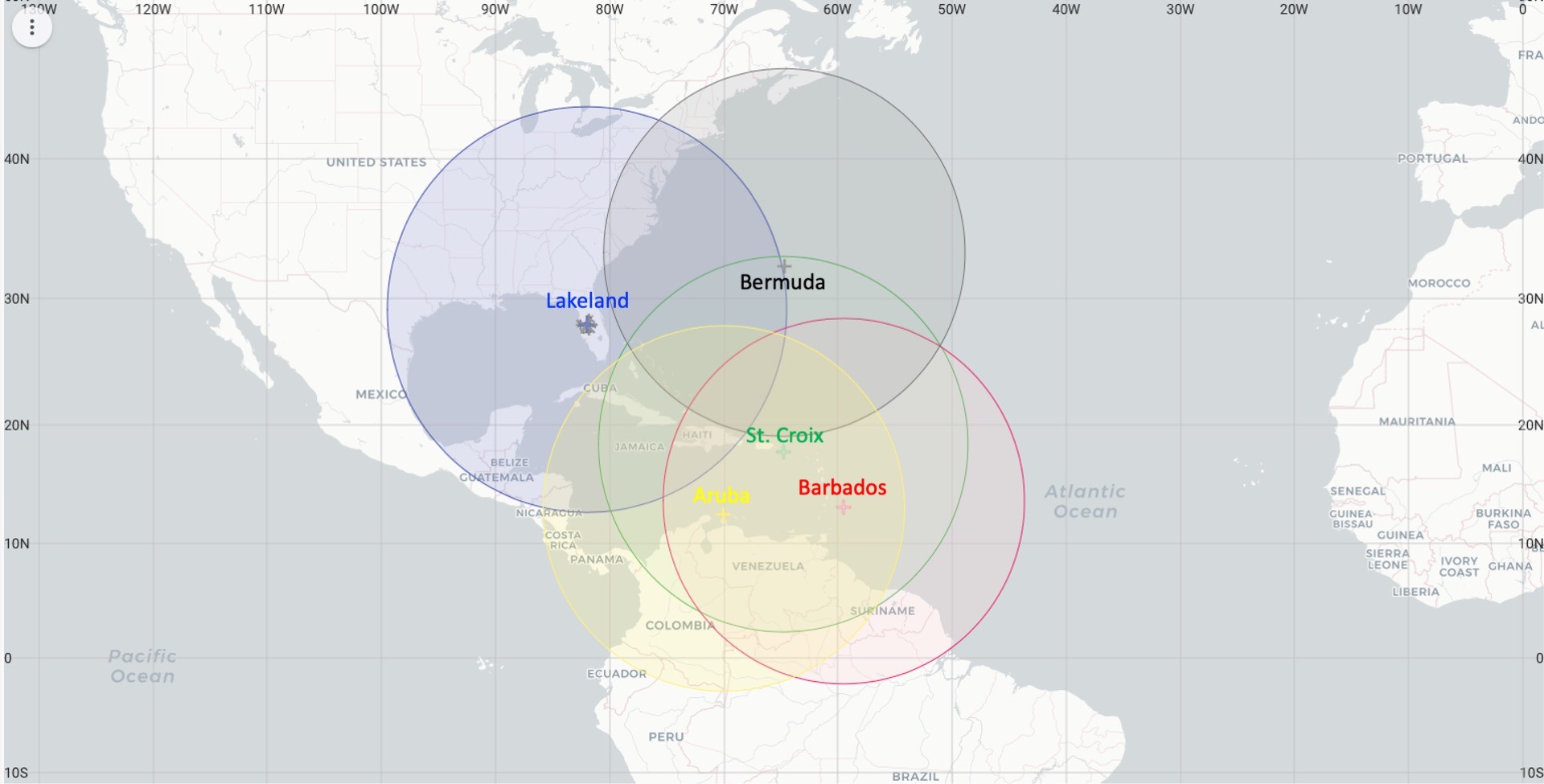
The P-3 Aircraft Operational Flight Map
Primary Atlantic operating bases and ranges (assuming ~2-h on-station time) for the P-3.
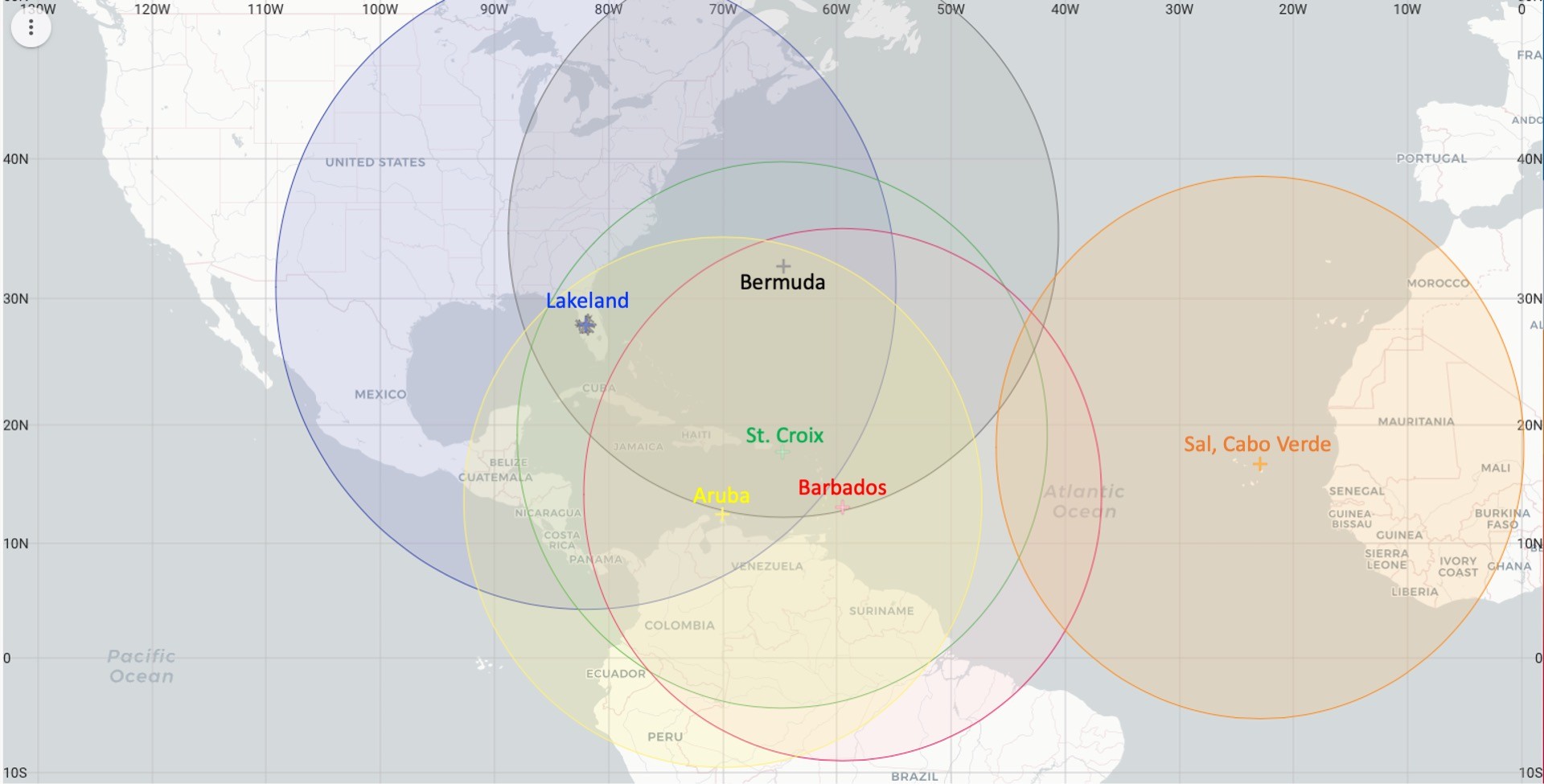
The G-IV Aircraft Operational Flight Map
Primary Atlantic operating bases and ranges (assuming ~2-h on-station time) for the G-IV.
Flight Patterns
Rotated Figure 4: P-3 & G-IV
- In-Pattern Duration:~ 5 h (P-3), ~ 2 h 55 min (G-IV)
- Leg Lengths: 105 n mi (195 km)
- Dropsondes: centers, mid-points and turn points of each leg [20 sondes total]
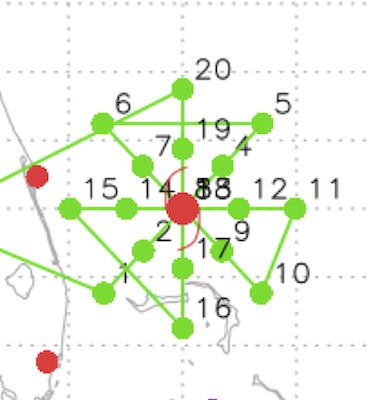
Appendices
Aircraft Information
